
Enlightenment Symbols
Enlightenment broadly means wisdom or understanding enabling clarity of perception. In religious use, enlightenment is most closely associated with South and East Asian religious experience, being used to translate words such as (in Buddhism) bodhi or satori, or (in Hinduism) moksha.
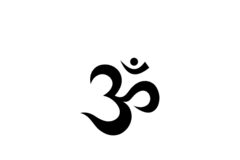
OM or Aum
The syllable om is first described as all-encompassing mystical entity in the Upanishads. Today, in all Hindu art and all over India and Nepal, 'om' can be seen virtually everywhere, a common sign for Hinduism and its philosophy and theology. Hindus believe that as creation began, the divine, all-encompassing consciousness took the form of the first and original vibration manifesting as sound "OM". Before creation began it was "Shunyākāsha", the emptiness or the void. Shunyākāsha, meaning literally "no sky", is more than nothingness, because everything then existed in a latent state of potentiality. The vibration of "OM" symbolizes the manifestation of God in form ("sāguna brahman"). "OM" is the reflection of the absolute reality, it is said to be "Adi Anadi", without beginning or the end and embracing all that exists. The mantra "OM" is the name of God, the vibration of the Supreme. When taken letter by letter, A-U-M represents the divine energy (Shakti) united in its three elementary aspects: Bhrahma Shakti (creation), Vishnu Shakti (preservation) and Shiva Shakti (liberation, and/or destruction).
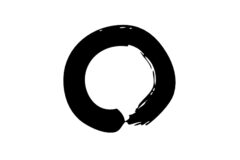
Ensō
Ensō is a Japanese word meaning "circle" and a concept strongly associated with Zen. Ensō is one of the most common subjects of Japanese calligraphy even though it is a symbol and not a character. It symbolizes the Absolute enlightenment, strength, elegance, the Universe, and the void; it can also symbolize the Japanese aesthetic itself. As an "expression of the moment" it is often considered a form of minimalist expressionist art.
In Zen Buddhist painting, ensō symbolizes a moment when the mind is free to simply let the body/spirit create. The brushed ink of the circle is usually done on silk or rice paper in one movement (but the great Bankei used two strokes sometimes) and there is no possibility of modification: it shows the expressive movement of the spirit at that time. Zen Buddhists "believe that the character of the artist is fully exposed in how she or he draws an ensō. Only a person who is mentally and spiritually complete can draw a true ensō. Some artists will practice drawing an ensō daily, as a kind of Spiritual Practice."
Some artists paint ensō with an opening in the circle, while others complete the circle. For the former, the opening may express various ideas, for example that the ensō is not separate, but is part of something greater, or that imperfection is an essential and inherent aspect of existence. The principle of controlling the balance of composition through asymmetry and irregularity is an important aspect of the Japanese aesthetic.
The ensō is also a sacred symbol in the Zen school of Buddhism, and is often used by Zen masters as a form of signature in their religious artwork.
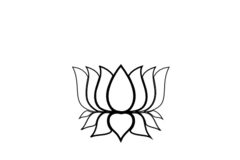
The Lotus
The lotus does not grow in Tibet and so Tibetan art has only stylized versions of it. Nevertheless, it is one of Buddhism's best recognized motifs since every important deity is associated in some manner with the lotus, either being seated upon it or holding one in their hands.
The roots of a lotus are in the mud, the stem grows up through the water, and the heavily scented flower lies above the water, basking in the sunlight. This pattern of growth signifies the progress of the soul from the primeval mud of materialism, through the waters of experience, and into the bright sunshine of enlightenment. Though there are other water plants that bloom above the water, it is only the lotus which, owing to the strength of its stem, regularly rises eight to twelve inches above the surface.
Significantly, the color of the lotus too has an important bearing on the symbology associated with it:
1). White Lotus: This represents the state of spiritual perfection and total mental purity (bodhi). It is associated with the White Tara and proclaims her perfect nature, a quality which is reinforced by the color of her body.
2). Red Lotus: This signifies the original nature and purity of the heart (hrdya). It is the lotus of love, compassion, passion and all other qualities of the heart. It is the flower of Avalokiteshvara, the bodhisattva of compassion.
3). Blue Lotus: This is a symbol of the victory of the spirit over the senses, and signifies the wisdom of knowledge. Not surprisingly, it is the preferred flower of Manjushri, the bodhisattva of wisdom.
4). Pink Lotus: This the supreme lotus, generally reserved for the highest deity. Thus naturally it is associated with the Great Buddha himself.

The Eight-Spoked Dharma Wheel
The wheel consists of three basic parts: the hub, the rim, and spokes (generally eight in number). Its underlying form is that of a circle, which is recognized across all traditions as a shape that is complete and perfect in itself, qualities which inform the teachings of the Buddha too.
Individually, the rim represents the element of limitation, the hub is the axis of the world, and the eight spokes denote the Eightfold Path set down by the Buddha, which leads to the cessation of all suffering.
The wheel evolved as a symbol of the Buddha's teachings and as an emblem of the Chakravartin or 'wheel turner,' identifying the wheel as the Dharmachakra or 'wheel of law.' The Tibetan term for Dharmachakra (chos kyi'khor lo) literally means 'the wheel of transformation.' The wheel's swift motion serves as an apt metaphor for the rapid spiritual change engendered by the teachings of the Buddha. Hence, Buddha's first discourse at the Deer Park in Sarnath is known as the 'first turning of the wheel of dharma.' Likewise, his subsequent discourses at Rajgir and Shravasti are known as the 'second and third turnings of the wheel of dharma.'
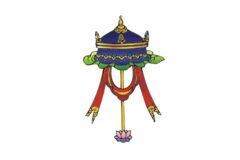
The Tibetan Parasol
The parasol or umbrella is a traditional Indian symbol of both protection and royalty. The ability to protect oneself against inclement weather has always been a status symbol. In Europe, until a few decades ago, a sunshade was a status symbol for society ladies. In Oriental thought, the fact that it protected the bearer from the scorching heat of the sun was transferred into the religious sphere as a "protection against the heat of defilements." Thus the coolness of its shade symbolizes protection from the heat of suffering, desire, and other spiritually harmful forces.
The dome of the umbrella is held aloft by a vertical handle (just like the mountain upholds the sky), which is identified with the 'axis mundi,' or the central axis upholding the world. The umbrella is carried above an important dignitary or the image of a deity, to indicate that the person or symbol below the umbrella is in fact the center of the universe, and also its spiritual support. Umbrellas seem to be especially important in processional rites, being like mobile temples. Thus, depictions of the Buddha often display an elaborate and large umbrella above his head.
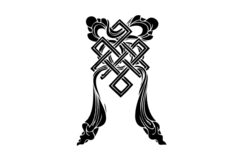
The Endless Knot
The endless knot is a closed, graphic ornament composed of right-angled, intertwined lines. It is conjectured that it may have evolved from an ancient naga symbol with two stylized snakes.
This latter image signifies the dramatic interplay and interaction of the opposing forces in the dualistic world of manifestation, leading to their union, and ultimately to harmony in the universe. This fact is amply reflected in the symmetrical and regular form of the endless knot.
The intertwining of lines reminds us how all phenomena are conjoined and yoked together as a closed cycle of cause and effect. Thus the whole composition is a pattern that is closed on in itself with no gaps, leading to a representational form of great simplicity and fully balanced harmony.
Since all phenomena are interrelated, the placing of the endless knot on a gift or greeting card is understood to establish an auspicious connection between the giver and the recipient. At the same time, the recipient is goaded to righteous karma, being reminded that future positive effects have their roots in the causes of the present. This is because the knot represents a connection, a link with our fates, binding us to our karmic destiny. Not surprisingly, this is one of the favorite symbols in Tibetan Buddhism, and often occurs independently on its own.
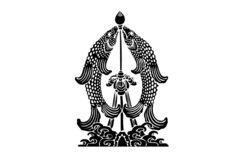
The Golden Fishes
This symbol consists of two fishes, which usually appear standing vertically with heads turned inwards towards each other.
The pair of fishes originated as an ancient pre-Buddhist symbol of the two sacred rivers of India, Ganga and Yamuna. Symbolically, these two rivers represent the lunar and solar channels, which originate in the nostrils and carry the alternating rhythms of breath or prana. In Buddhism, the golden fishes symbolize happiness, as they have complete freedom in water. They represent fertility and abundance as they multiply very rapidly. Fish often swim in pairs, and in China they represented conjugal unity and fidelity, where a pair of fishes would often be given as a wedding present.
Both Jesus Christ and Buddha are known as 'fisher of men,' because they save mortals from the ocean of suffering.
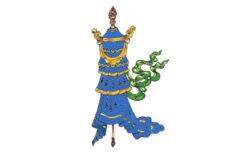
The Victory Banner
In Sanskrit, the banner or sign of victory is known as the dhvaja, meaning standard, flag or ensign. Originally, the victory banner was a military standard carried in ancient Indian warfare, and bore the specific insignia of its champion. For example in the Mahabharata, Krishna's chariot was adorned with a banner showing the image of the monkey-god Hanuman.
The victory banner was adopted by early Buddhism as an emblem of the Buddha's enlightenment, heralding the triumph of knowledge over ignorance. It is said to have been placed on the summit of Mt. Meru by Buddha himself, symbolizing his victory over the entire universe. Again, Mount Meru here is believed to be the central axis supporting the world.
The flag of victory also denotes Buddha's triumph over Mara, who personifies hindrances on the path to spiritual realization. Specifically, there are said to be four types of Maras, each one representing an individual hurdle on the path to spiritual progress. These are:
1) The Mara of Emotional Defilement
2) Mara of Passion
3) Mara of the Fear of Death
4) Mara of Pride and Lust
It was only after conquering these four negative traits that Buddha could proclaim victory over ignorance, and achieve nirvana.
Cylindrical victory banners made of beaten copper are traditionally placed at the four corners of monastery and temple roofs. These signify the Buddha's victorious dharma radiating to the four directions and also his triumph over the four Maras mentioned above.
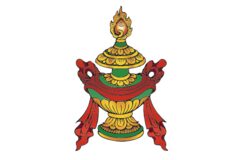
The Vase of Inexhaustable Treasures
The vase is a fat-bellied vessel with a short, slim neck. On top, at the opening, there is a large jewel indicating that it is a treasure vase.
Physically, the 'vase of inexhaustible treasures' is modelled on the traditional Indian clay water pot or kumbha with a flat base, round body, narrow neck and fluted upper rim. However much is removed from it, this vase remains perpetually full. Wealth vases, sealed with precious and sacred substances, are commonly placed upon altars and on mountain passes, or buried at water springs, where their presence is believed to attract wealth and bring harmony to the environment. In relation to Buddhism it specifically means the spiritual abundance of the Buddha, a treasure that did not diminish, however much of it he gave away.
The question still remains of the association of these eight symbols with the Buddha's actual physical body. An ancient text called the Heap of Good Fortune Sutra (Aryamangalakutanama-mahayanasutra), while addressing the Buddha, has this to say on the issue:
Veneration to you with your head like a protecting parasol,
With eyes like the precious golden fishes (even today a woman with beautiful eyes is known as 'minakshi,' meaning one with fish-like eyes)
With neck like a precious, adorned vase of good fortune,
With speech like a right-turning Dharma shell,
With a mind infinite with wisdom like the never ending knot,
With a tongue open like the auspicious pink lotus,
With a body proclaiming triumph over the attacking armies of Mara,
With feet that tread the path of dharma like the auspicious wheel.
Artistically, these motifs may be depicted individually, in pairs, in fours, or as a composite group of eight. Designs of these eight symbols adorn all manner of sacred and secular Buddhist objects, such as carved wooden furniture, metalwork, wall panels, carpets and silk brocades.
They are also frequently drawn on the ground in sprinkled flour or colored powders to welcome visiting religious dignitaries. Indeed, no Tibetan ceremony, be it religious or secular (for e.g. a marriage), is complete without some depiction of the eight auspicious symbols of Buddhism, which are believed to propitiate the environment and grant protection to the activity being undertaken.
- Contact Us
- About Us
- Looking for a bargain?
Shop Our Amazon.com Store - Place Card Printing Templates









